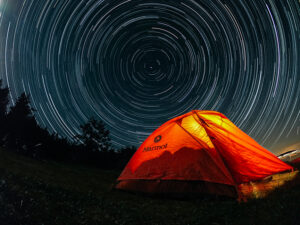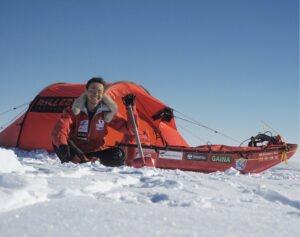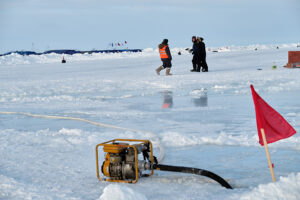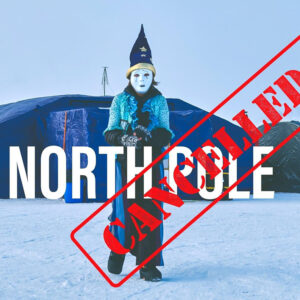Although I’ve done many expeditions to both the North and South Poles, both as an independent traveler and a guide, every fresh trip brings up new gear ideas. There are also old, tried-and-true standards that I have used for years. As I begin the South Pole season, let’s take a look at my gear. Today: The controversial vapor-barrier liner (VBL).
One note: Proper gear is just one aspect of polar travel. Developing skills, planning and logistics, understanding the polar environment, and knowing how to minimize risk are all equally important. If you would like to fast-track your development as a polar traveler, consider hiring an IPGA Polar Expedition Guide.
Vapor barriers
As the name suggests, a vapor-barrier liner is an inner layer of waterproof material that locks moisture next to the skin. It aims to prevent perspiration from moving into, and potentially freezing, insulating layers. You use VBLs with boots and sleeping bags.
You don’t notice ice build-up for the first few days, but over the weeks, it can render sleeping bags almost useless and turn boots into frozen coffins that your poor feet need to melt into softness every morning.
Keeping moisture next to your feet with a VBL is not ideal, but it’s a lesser evil. And because you don’t remove boots during the day, the temperature remains relatively regulated, so long as your breaks are not too long.
Unlike footwear, we can tinker with handwear layering on the fly to vent heat and moisture. It’s a skill that every polar traveler must learn. Never use vapor barriers on your hands. The use of Latex gloves or other impervious barriers can quickly lead to frostbite. You must keep fingers dry.

Using a VBL in the sleeping bag while skiing from Russia to the North Pole in 2002. Photo: Eric Philips
It’s also important to use a VBL in your sleeping bag in extreme cold. Without it, moisture from your body will pass into the insulation of your bag, then freeze before reaching the outer shell. You simply can’t generate enough heat to push it all the way out. Ice build-up inhibits the insulating capacity of your bag, especially a down bag. It becomes extremely difficult to dry. Left untreated, you will feel the crunchiness build up in the insulation.
Don’t use a silk or fleece liner inside the VBL. It will get wet and is difficult to dry. Sure, the base layers that you sleep in will get damp, but you can dry them out next to your skin pretty quickly. A good layering rule for sleeping in these conditions: base layers, VBL, down inner bag, and synthetic outer bag.
When to use VBLs
There are no rigid parameters that dictate when to use VBLs. Instead, it is based on equipment, temperature, and amount of sunlight. For example, there’s no need for a VBL with Intuition boot liners, as they are made from closed-cell foam. As a rough guideline, VBL usage correlates loosely with solar charging. If you can charge a power bank daily from a 21W solar panel, you likely won’t need VBLs. If it’s not too windy, you can lay your sleeping bag in strong sunshine during morning chores, and the accumulated overnight moisture will sublimate out.
When in doubt, use VBLs on your feet.
Lying in a plastic bag is unpleasant, so you might be able to use other methods to minimize ice accretion in your sleeping bag. Any ice in the tent (frozen steam, icy clothing, etc.) can contribute to moisture in your sleeping bag if that ice is allowed to melt. Some people mitigate this by keeping the ambient temperature in the tent well below freezing, but this means no stove inside. I have never felt the need, or desire, to do this. It’s a pretty uncomfortable strategy at -30°C, so it is better to be familiar with alternatives that allow using a stove in the tent.
How successfully you vent during the day has a bearing on how comfortable your tent will be at night. There will likely be ice on your facial coverings, so be sure to scrape it off outside the tent with a grout brush before drying inside. You’ll need to bring damp liner socks and inner boots into the tent, but other clothing layers should be totally dry on entering.

Philips during his Russia-to-North-Pole expedition. Late March 2002. Photo: Eric Philips
Scrape ice off your shell clothing and ruff but leave them in the vestibule with your outer boots. Ice will build up on the inner tent from steam during cooking, so minimize it. Even your breath will contribute.
In the morning, meticulously brush ice off the inner tent and from your sleeping bag before lighting a stove (or place your sleeping bag in the vestibule or outside before lighting). Keep a dry microfibre cloth handy to wipe up any dampness on your bag, but be sure to dry the cloth out so that you can reuse it.
Using a stove inside a tent is common on polar expeditions but it is dangerous and must be done with care and precision.
Staying dry from the inside
The following pertains to long expeditions in no or low-sun polar environments. This means the Arctic rather than the Antarctic since Antarctic expeditions take place during the austral summer, when the sun is high. Overnight, the average person sweats and exhales approximately 200ml of moisture. This varies based on body temperature, diet, and gender.
If using a sleeping bag VBL, it should be quite long so you can breathe into it. In severe cold, you need to cinch your hood right down. Sometimes it’s too cold to have your face exposed, forcing you to breathe into your VBL the whole night. Of course, you still need oxygen, so don’t block that aperture.

Jon Muir in his VBL. Russia to the North Pole, March 2002. Photo: Eric Philips
I would personally never use a single-down bag without a VBL on a polar expedition that does not benefit from solar warming. Ice build-up will eventually collapse the down, if left unmanaged.
If not using a VBL, avoid bringing damp clothing or boots into your sleeping bag to dry out. That just adds to the problem.
In the morning, I use my microfibre cloth to soak up any dampness on the shell.

Martin Hartley and Bernice Notenboom tucked up against the cold. North Pole to Canada, April 2014. Photo: Eric Philips
Note that red tents have a superior greenhouse effect, while green is better for sunny Antarctica.
Dealing with moisture in the polar regions requires active management. You can’t let anything slip. Take every opportunity to keep ice buildup under control.






